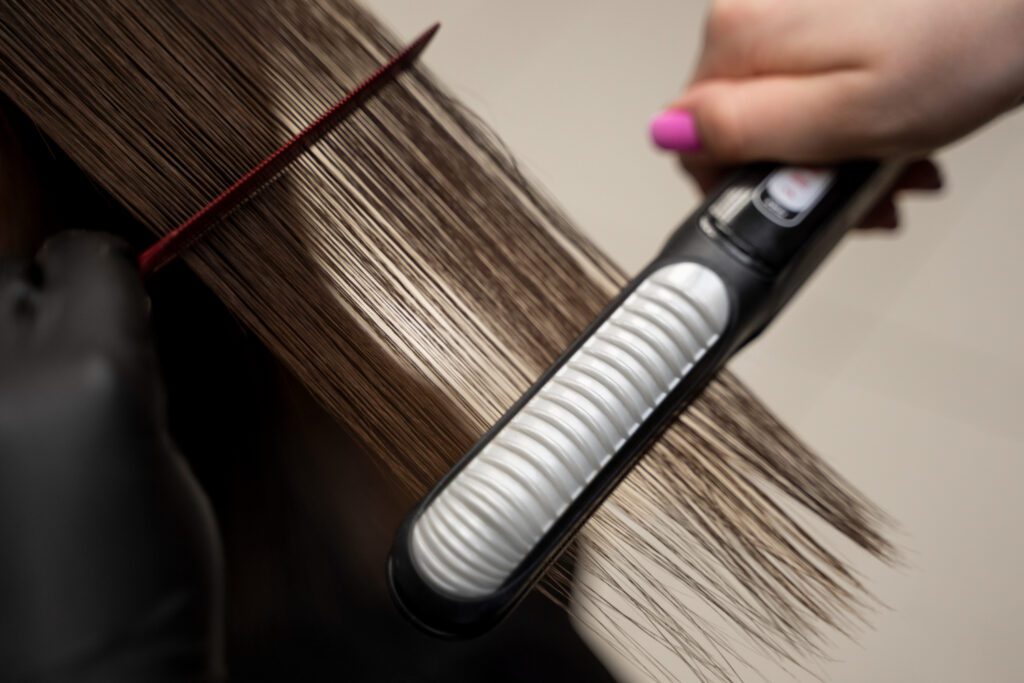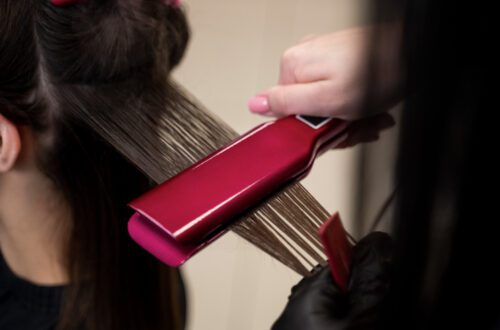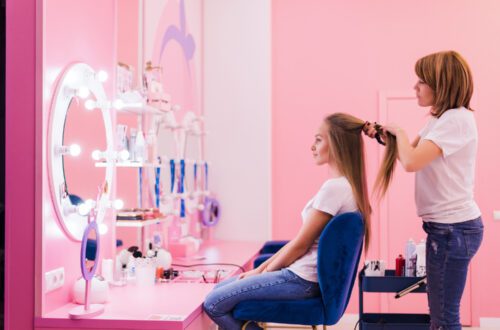
Neutralizer for Hair Straightening
A Neutralizer for hair straightening is used to balance the pH level of the hair after the straightening process. It helps to lock in the straightened shape and prevent any further damage to the hair.
Having silky straight hair is a dream for many, and with the increasing popularity of hair straightening treatments, it is now more achievable than ever. However, the process of hair straightening involves using chemical products that can disrupt the natural PH balance of the hair.
This is where a Neutralizer comes into play. By restoring the pH level of the hair, it helps to seal in the straightened shape and ensure long-lasting results. We will explore the importance of using a Neutralizer for hair straightening and how it can benefit your hair. So, if you are someone who loves to have straight hair, keep on reading to find out more!
The Science Behind Neutralizer For Hair Straightening
Hair straightening has become a popular trend in recent years, allowing individuals to achieve smooth, sleek locks. However, the science behind this process is often overlooked. In this blog post, we’ll explore the fascinating world of neutralizer for hair straightening and the role it plays in achieving beautiful, straight hair.
How Neutralizers Work
Neutralizers are an essential component of the hair straightening process. They work by stabilizing and resetting the hair’s structure after the hair has been chemically treated with a straightening solution. By neutralizing the pH balance of the hair, these agents help lock in the straightening effects, ensuring long-lasting, silky results.
Role of Neutralizers in Hair Straightening Process
During the hair straightening process, the neutralizer works to restore the hair’s pH balance, which may have been altered by the straightening solution. After the straightening solution breaks down the hair’s natural bonds, the neutralizer steps in to reestablish these bonds in a new, straight configuration. This reformation ensures that the hair retains its smooth, straight appearance even after subsequent washes.
Chemical Reactions Involved in Neutralization
This process of neutralization involves a chemical reaction between the hair straightening solution, commonly referred to as a relaxer, and the neutralizer. Relaxers typically contain alkaline ingredients that raise the hair’s pH level, allowing it to become more malleable and easier to straighten. The neutralizer, on the other hand, is acidic and helps lower the hair’s pH level back to its normal range, effectively stopping the relaxing process and restoring the hair’s natural structure.
Importance of pH Balance in Neutralization
In the world of hair straightening, maintaining the right pH balance is crucial for successful results. The pH scale ranges from 0 to 14, with a pH of 7 considered neutral. Hair typically has a slightly acidic pH, ranging from 4.5 to 5.5. It’s important for the neutralizer to bring the hair’s pH back into this acidic range to ensure optimal hair health and long-lasting straightening effects. The correct pH balance not only helps to reestablish the hair’s natural strength but also ensures that the hair shaft remains smooth and resistant to frizz.
So, the next time you embark on a hair straightening journey, remember the vital role that neutralizers play in achieving those sleek, straight locks. They work behind the scenes, restoring the hair’s natural structure and leaving you with stunning, straight hair that lasts.
Choosing The Right Neutralizer For Hair Straightening
When it comes to hair straightening, choosing the right neutralizer is crucial for achieving the desired results. A neutralizer is an essential part of the hair straightening process as it helps to set the hair in its new shape and ensures that the straightening lasts longer. But with so many options available, how do you know which neutralizer is right for you? In this article, we will discuss the different types of neutralizers and the factors to consider when choosing one.
Understanding Different Types of Neutralizers
Neutralizers come in two main types: acidic neutralizers and alkaline neutralizers. Each type has its own unique properties and benefits. Let’s take a closer look at each one:
Acidic Neutralizers
Acidic neutralizers are commonly used for hair straightening techniques that use an alkaline straightening solution. These neutralizers work by balancing the pH of the hair after the straightening process, ensuring that the hair shafts are sealed and the new shape is retained. Acidic neutralizers are typically formulated with ingredients like citric acid or lactic acid, which are gentle on the hair and scalp.
Alkaline Neutralizers
Alkaline neutralizers are used for hair straightening techniques that use an acidic straightening solution. These neutralizers also help to balance the pH of the hair after the straightening process, but they work differently than acidic neutralizers. Alkaline neutralizers contain ingredients like ammonium thioglycolate or sodium bromate, which help to restructure the hair and enhance the straightening effect.
Factors to Consider When Choosing a Neutralizer
Now that you have a better understanding of the different types of neutralizers, let’s explore the factors to consider when choosing the right one for your hair straightening needs:
- Hair type: Consider the texture and condition of your hair. Some neutralizers are more suitable for fine hair, while others are designed for thick or coarse hair.
- Straightening technique: Different hair straightening techniques may require specific neutralizers to achieve the best results. Depending on whether you are using an alkaline or acidic straightening solution, you will need to choose the corresponding neutralizer.
- Sensitivity: If you have a sensitive scalp or are prone to allergic reactions, opt for a neutralizer that is formulated for sensitive skin.
- Professional recommendation: Consult with a professional hairstylist or a hair straightening expert to get their recommendation on the best neutralizer for your hair type and desired results.
In conclusion, choosing the right neutralizer is essential for successful hair straightening. Whether you opt for an acidic or alkaline neutralizer, consider factors such as hair type, straightening technique, sensitivity, and seek professional advice. By selecting the appropriate neutralizer for your needs, you can achieve long-lasting, sleek, and smooth hair.
Step-By-Step Guide To Using Neutralizer For Hair Straightening
Achieving sleek, straight hair can be a game-changer for anyone looking to switch up their style. After undergoing a hair straightening treatment, it is crucial to properly neutralize the hair to ensure long-lasting and silky smooth results. In this step-by-step guide, we will walk you through the process of using a neutralizer to complete your hair straightening treatment. Let’s dive in!
Preparing the Hair for Neutralization
Before applying the neutralizer, it is essential to properly prepare the hair to ensure optimal results. Begin by thoroughly rinsing out any remaining straightening solution or product from the hair using lukewarm water. Make sure to remove all traces of the straightening formula to prevent any residue from interfering with the neutralizer’s effectiveness.
Shampooing and Conditioning
Once the hair is free from any straightening solution, it’s time to cleanse and condition the strands. Start by selecting a gentle shampoo formulated for chemically treated hair. Massage the shampoo into the hair and scalp, focusing on the ends where product build-up is more likely to occur. Thoroughly rinse out the shampoo, and follow up with a nourishing conditioner designed to hydrate and repair the hair.
Drying the Hair
After rinsing out the conditioner, gently towel-dry the hair to remove excess moisture. It’s important to note that blow-drying the hair can cause frizz and potentially reverse the effects of the straightening treatment. To avoid this, try air-drying the hair or using a cool setting on your blow dryer.
Applying the Neutralizer
Now that the hair is clean and dry, it’s time to apply the neutralizer. Begin by dividing the hair into sections to ensure even coverage. Take a generous amount of neutralizer and apply it to each section, starting from the roots and working your way down to the ends. Comb the product through the hair, making sure that every strand is coated with the neutralizer solution.
Ensuring Even Coverage
To ensure that the neutralizer is evenly distributed throughout the hair, gently comb through the strands once more after applying the product. This will help prevent any areas from being missed and ensure that all parts of the hair receive the same level of neutralization.
Timing and Processing
Leave the neutralizer on the hair for the recommended processing time specified on the product instructions. This time may vary depending on the specific brand and type of neutralizer being used. It is crucial to follow the instructions carefully to avoid under-neutralization or over-processing, which can lead to less-than-desired results.
Neutralizer Removal and Post-Treatment Care
After the processing time is up, it’s time to remove the neutralizer from the hair. Rinse the hair thoroughly with lukewarm water until the water runs clear. Ensure that no traces of the neutralizer remain, as this can cause damage to the hair over time.
Rinse and Condition
Follow up the neutralizer removal with a final rinse of cool water to help seal the hair cuticle and add shine. Finish by applying a leave-in conditioner or a lightweight serum to protect and nourish the hair.
Styling and Maintenance Tips
Now that you have achieved straight, smooth hair, here are a few styling and maintenance tips to keep your hair looking its best:
– Avoid heat styling tools: Minimize the use of heat styling tools such as straighteners and curling irons to prevent damage and maintain the straightened look.
– Use a heat protectant: When using heat styling tools, always apply a heat protectant spray or serum to shield the hair from heat damage.
– Sleep on a silk pillowcase: Switching to a silk pillowcase can help reduce friction and prevent frizz and tangles while you sleep.
– Regular trims: Schedule regular trims to keep your hair healthy and prevent split ends from ruining your straightened look.
– Deep conditioning treatments: Treat your hair to occasional deep conditioning treatments to keep it hydrated, nourished, and smooth.
By following this step-by-step guide and implementing these styling and maintenance tips, you can make the most out of your hair straightening treatment and enjoy beautifully straightened hair for weeks to come.
Common Mistakes To Avoid When Using Neutralizer For Hair Straightening
When it comes to hair straightening, using a neutralizer is an essential step to achieve smooth and sleek hair. However, it is important to be aware of the common mistakes that can occur when using a neutralizer. These mistakes can lead to over-processing, uneven distribution, and neglecting post-treatment care, which can have negative effects on the hair. In this blog post, we will explore these common mistakes and offer tips to avoid them, so you can achieve beautiful, healthy hair after the neutralization process.
Over-Processing the Hair
Over-processing the hair with a neutralizer can lead to damage and breakage. It is crucial to follow the recommended processing time provided by the manufacturer. **Do not exceed the recommended time** to avoid overexposure to the chemicals in the neutralizer. Pay attention to the hair’s texture and condition during the process, as different hair types may require different processing times.
Effects of Overexposure to Neutralizers
Overexposure to neutralizers can cause dryness, frizz, and weakened hair strands. **Long exposure to neutralizers can strip the hair of its natural moisture and oils**. This can result in brittle and dull hair, making it prone to breakage and split ends.
How to Prevent Over-Processing
To prevent over-processing, it is important to perform a strand test before applying the neutralizer to the entire head. This will help determine the appropriate processing time for your hair type. Additionally, **apply the neutralizer evenly**, ensuring that all strands are covered, but without saturating the hair excessively. This will help achieve consistent results without overexposure.
Incorrect Application Techniques
Incorrect application techniques can lead to uneven results and possible damage to the hair. Follow the manufacturer’s instructions carefully to ensure proper application. **Avoid excessive rubbing or massaging of the hair during the neutralization process**, as this can cause tangling and breakage. Instead, gently smooth the hair to distribute the neutralizer evenly.
Uneven Distribution of Neutralizer
An uneven distribution of the neutralizer can result in patches of straightened and unstraightened hair. **Divide the hair into sections** and apply the neutralizer systematically, working from roots to ends. Use a wide-tooth comb or your fingers to comb through the hair to distribute the product evenly. This will help achieve a uniform straightening effect.
Not Following Manufacturer Instructions
Ignoring the manufacturer’s instructions can lead to unexpected results and potential damage to the hair. **Always read and follow the instructions that come with the neutralizer**. These instructions are designed to ensure safe and effective use of the product. If you have any doubts, reach out to the manufacturer or consult a professional hair stylist for guidance.
Ignoring Post-Treatment Care
Post-treatment care is crucial to maintain the health and vitality of the hair after neutralization. **Do not neglect moisturizing and nourishing your hair**. Use a deep conditioning treatment regularly to replenish moisture and restore the hair’s natural shine. Avoid using heat-styling tools excessively, as they can further damage the hair. Protect your hair from the sun’s harmful rays by wearing a hat or using a UV-protective product.
Importance of Moisturizing and Nourishing the Hair
Moisturizing and nourishing the hair is essential to keep it healthy, especially after the neutralization process. **Choose hair products that are specifically designed for chemically treated hair**. These products will help restore moisture, repair any damage, and keep the hair soft and manageable. Incorporate a leave-in conditioner or hair oil into your routine to provide extra hydration and protect the hair from environmental damage.
Tips for Maintaining Healthy Hair after Neutralization
After neutralization, it is important to establish a hair care routine that promotes and maintains the health of your hair. Here are some tips to help you maintain healthy hair:
- Limit the use of heat-styling tools to prevent further damage.
- Avoid tight hairstyles that can cause tension and breakage.
- Trim the ends of your hair regularly to prevent split ends.
- Protect your hair from chlorine and saltwater by wearing a swim cap or rinsing your hair with clean water before swimming.
- Stay hydrated and maintain a balanced diet to promote hair health from within.
By following these tips and avoiding the common mistakes mentioned above, you can enjoy the benefits of using a neutralizer for hair straightening while keeping your hair healthy and beautiful.

Frequently Asked Questions For Neutralizer For Hair Straightening
What Happens If You Don T Use Neutralizer After Straightening?
Not using a neutralizer after straightening can cause the hair to revert back to its natural state. It can result in loss of smoothness and increased frizz. The neutralizer helps to set the hair in its newly straightened form and maintain the results of the straightening process.
Is Neutralizer Good For Hair?
Neutralizer is beneficial for hair as it helps to restore the pH balance after chemical treatments, such as perms or relaxers. It helps to close the hair cuticles, making hair smoother and shinier. It is an important step in the hair care process to maintain healthy and manageable hair.
Can I Use Neutralizer Without Straightening Cream?
Yes, you can use a neutralizer without a straightening cream.
What Do You Apply First Neutralizer Or Straightening Cream?
Apply neutralizer first before applying straightening cream to achieve the desired results.
Conclusion
To wrap it up, a high-quality neutralizer is essential for maintaining your hair’s straightened look. Its pH-balanced formula helps to restore your hair’s natural state by neutralizing the chemicals used in the straightening process. By incorporating a neutralizer into your hair care routine, you can ensure that your hair remains smooth, silky, and healthy.
So, don’t overlook the importance of a reliable neutralizer for Long-Lasting Straight Hair!




